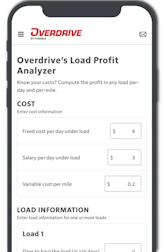Previously in this two-part examination of oil-drain recommendations and practices: Owner-ops adapt conservative approach to ever-expanding diesel service interval recommendations
The most important benefit truck owners get from engine oil performance is protection from engine damage. Changing oil more often than required will always be preferable to a breakdown, necessity of an engine overhaul or rebuild, and all the accompanying downtime.
It's not just owners who sample and test their oil with a qualified lab and do “believe in the numbers” analysis reveal, as Brandon Scates put it in the first part of this story, that can benefit from extended drains. There are a number of practices many have implemented to ensure they’re getting the most out of their oil -- and the engine itself.
The above chart shows some of those practices outlined by the two-thirds of Overdrive survey respondents who said they’re extending oil changes beyond the traditionally conservative 15,000-mile drain.
The most common tactic, utilized by 36% of respondents, is simply avoiding engine idling by utilizing an auxiliary power unit (APU) or other means of shore power. While OEMs make their change interval recommendations contingent on fuel mileage achieved, idle time should be another indicator owners use to determine oil life.

Kurt Braunel is co-owner with his brother, Clint Braunel, of the Clean Air Fleet (CAF) company, which manufactures oil and fuel filtration systems and additives. Kurt called idle time a “huge indicator" in helping determine when to change, or the truck's average speed over time, which can be indicative of more stop-and-start applications like local city work, or more long-haul operations.
"If they’re idling half the time, I would change the oil a lot sooner than the guy that’s running his APU half the time, by far,” Kurt Braunel said.
When a new customer comes to Clean Air Fleet, Kurt added, one of the first questions the company asks is whether the customer is utilizing an APU, and if/how much they idle their truck. He highlighted one CAF customer with an APU who “got a million miles on his Cummins,” he said. The time on the customer's APU was upwards of 10,000 hours. Had that been idle time instead, “that would double the amount of hours” on the engine, the customer told him.
Braunel said he's seen customers' trucks “literally idling more than they’re driving, which is weird because now you’re using a 15-liter engine as basically a generator to get shore power,” he said. “So you’re like, ‘Oh, I got power to run my fridge and my TV and whatever,’ … but you’re killing your engine.”
Behind reducing idle time in the survey results, between a fifth and a quarter of owner-operators reported using oil and/or fuel additives to get more life out of their oil.
Alec Costerus, owner of Alpha Drivers Transportation, said his fleet uses additives from Hot Shot’s Secret, including the FR3 Friction Reducer oil additive. Like Overdrive 2023 Trucker of the Year Jay Hosty's example provided in Part 1 of this story, ADT is something of an outlier in trucking in stretching change intervals to a grand total of once a year, at around 150,000 miles. It’s because "we optimize everything," Costerus said -- the company uses a bypass oil filtration system, and high-quality oil and additives alike.
He said it’s “important to get the right oil that meets the proper oil specification standard for each manufacturer,” because “as the newer technologies have evolved, you've really got to stay up to snuff” to properly take care of the engine. “You can’t do what your daddy did 30 years ago. That’s probably not ... best practices. Like everything else, everything about a truck is much more sophisticated.”
As Costerus has it, if owners are using the proper oil for their engines but are still changing oil in sub-15,000-mile intervals, “you’re really throwing out good oil at that point. The oil is still very good. The oil technologies have improved immensely, and you’re throwing out what is still a perfectly good oil.”
[Related: They said he'd fail, but he proved them wrong: Overdrive Trucker of the Year Jay Hosty]
CAF's Clint Braunel echoed Costerus’s sentiment: “we can safely tell [owners] we can take that oil at 10,000 miles" and put it in another diesel vehicle -- such as the personal pickup. "They’re throwing away a brand-new product.”
CAF's been manufacturing fuel additives for more than 20 years, and the Braunels highlighted the importance of their use. By using fuel additives, “if you’re lowering the soot in the combustion chamber by a more complete burn," Kurt noted, "it actually lowers the soot in the oil,” meaning cleaner oil is flowing through the engine.
Many owners think of additives as a winter necessity to prevent gelling, but not necessarily needed in the summer when cold temperatures aren’t a concern. Longtime Howes Diesel Treat winter fuel anti-gel additive provider Howes has also offered its all-weather Diesel Defender additive as a "maintenance dose" to promote cleaner burns, according to company President Rob Howes.
With a larger amount of its IDX4 detergent than the winter formula, Defender can "keep you clean throughout the winter," he said. "Defender has enough in it to actually clean up existing problems. And that's a key distinction because you want to treat with something in the summertime, you want to clean it up. The fuel's a little bit better in the summertime, so use that opportunity to clean the whole system out, get your fuel mileage back up."
Fuel quality has changed over the last couple of decades, Kurt Branel noted. “When we started out” at Clean Air Fleet, attitudes toward “additives were kind of like, 'well, whatever,' because the fuel was better quality, the low sulfur, all that stuff,” he said. “And as it’s just progressed over the years, I think the popularity and even the necessity of it" has jumped. It's considered "not just optional. It’s like they need this.”
[Related: Fuel treatments increasingly part of owner-operators' PM routine]
Importance of oil sampling and analysis, and a case for bypass filtration
Ultimately, how far to push the envelope on change intervals will come down to the comfort level of any individual owner. Changing oil every 10K-15K miles is playing it extremely safe, yet it could also be costing you money on oil and filters you don’t need to spend. For some, though, the peace of mind knowing you have clean oil flowing through the engine is priceless.
Karin Haumann, OEM technical services manager for Shell Rotella, said earlier this year at the Mid-America Trucking Show that sampling and analysis is “a quantifiable way to show ... that there’s more life left in the oil."
Putting oil sampling and lab analysis into the preventive maintenance routine could be invaluable, as it has been for owner-operators Scates and Hosty. Not only will it show if your oil is still in good enough condition to protect the engine, it can also show if there are other issues that need to be addressed in the engine and emissions systems, such as if there’s diesel in the oil (which points to an injector issue) or something else.
Confidence in oil performance, if you trust what analysis shows you, is a by-product. Bypass filtration systems, with the ability to remove ever-finer particles from the oil itself, can play a role, though they're only being used by about 9% of owners, according to Overdrive's survey.
Given longstanding short-interval practice, “it makes people very nervous to go 40, 50, 60, 80, 90” thousand miles, Haumann said. “If someone wants to use a more expensive, high quality, full synthetic oil,” such as Rotella’s T6, she said, “and they want to get more life out of it because it’s more expensive, they can do the oil analysis, which shows them that the fear is not warranted.”
Analysis might not only deliver indicators of “the life left in the oil,” she added, but “it can also be an indicator of the health of the engine. It can flag some problems emerging that you can catch before they become big problems.”
Additional filtration provided by bypass systems might ward off some of those problems, too. Some owners see the systems as among the most impactful options for extending oil and engine life.
The Alpha Drivers Transportation small fleet, certainly on the high end of extended drains, use a bypass system for filtering high-quality oil in their highly efficient Volvo tractors. ADT owner Alec Costerus noted that when he was a solo owner-operator in the early 2010s, he ran an OPS oil filtration system on his truck to extend oil life. Two to three years ago, ADT co-owner Joel Morrow found the Harvard Filtration company and has added their filtration system to both their 2023 Volvo VNL760 and 2026 Volvo VNL860.
[Related: In a tough trucking-business environment, owner-operators must improve efficiency to compete]
Costerus said the Harvard system has a five-gallon capacity in addition to the 10-11 gallons of oil in the engine, “and we’re purifying the oil constantly” within the system. Because of the larger filtration system and larger filters, ever-finer particles are filtered out of the oil, ensuring it’s as clean as possible when it runs through the engine.
“That’s not an inexpensive system, but we think by using the best oils and additives, the best filtration system, in the long run, it’s more economical, even though you have a higher up-front cost,” Costerus said. Between the money saved on oil and filters, in addition to the saved downtime with no need to change oil at more frequent intervals, the system “paid for itself very, very quickly."
Using the Clean Air Fleet's Oil Purifier bypass system, Clint Braunel said, owners should sample the oil for analysis every 25K-30K miles.
 CAF's Oil Purifier removes particles from the oil down to one micron in size. Compare that to others common among truck owners, such an Amsoil bypass filter that removes contaminants down to two microns, or the OPS filter from Pittsburgh Power at three microns.
CAF's Oil Purifier removes particles from the oil down to one micron in size. Compare that to others common among truck owners, such an Amsoil bypass filter that removes contaminants down to two microns, or the OPS filter from Pittsburgh Power at three microns.
“Change the filter, take the sample,” Kurt said. “Usually we’d say, go to like 50 or 60 [thousand miles] on one service where you’re changing the filter and taking a sample in between that.”
The Braunels acknowledged that even at 70K-75K miles, the oil could still very well be in good shape to continue running, but their goal is to ensure long engine life.
“The point isn’t trying to save 10 gallons of oil and make it last a year or two,” Kurt said. “We don’t have anybody that does that because, again, it’s only 10, 12 gallons of oil. The whole point is trying to protect your engine, not protect your 10 gallons of oil.”
One CAF fleet customer “routinely gets 80 to 100,000-plus miles out of oil, but they run really good oil in our opinion, and they change their filters religiously at 20,000, so they can do that,” Kurt said. “But you've got to be running a good oil, too.”
[Related: Pull off extended drains for your diesel with routine analysis]













